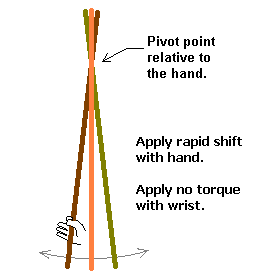Hey all -- I'm doing some research into how a pommel, or lack of affects sword handling.
Soooo, I have a favor to ask of anyone who has a "functional" katana. The more traditional, the better, but I also need a variety of swords tested, to look for a pattern.
I'm trying to find the "Pivot Point" of various swords. The way you find it is this: tie a string around the handle where you would normally grip the sword. (If you mostly grip using your middle finger, tie it there.) If you don't want to bother with a string, you can loosely hold it with your fingers, just be careful not to put any lateral influence on the sword.
Then, holding only the string, "waggle" your sword in a small circle. There will be a place somewhere along the blade that doesn't move. The rest of the sword will sort of "pivot" around it. This is the "Pivot Point". If some people will test their sword for me, and post the location of their pivot point measured from the tip, along with the overall blade length, I would really appreciate it. I would do it myself, but I've never even seen a true katana in my life, much less have access to one for testing.
If you want to include other types of swords, please feel free, just let me know what kind of a sword it is. (Chinese Broadsword, and Wakizashi would be interesting to test, as well.)
All I've been able to test so far (other than rapiers or longswords) is a shinai, and its pivot point is about 12 inches from the tip, or 1/3 of the blade.
My theory is this: For a well balanced blade that doesn't use a pommel (the counterweight is in the tang) I'm predicting that the Pivot point will consistently be 1/3 the distance from the tip to the point where you are holding the sword. If it does use a pommel, then the Pivot point will vary.
Soooo, I have a favor to ask of anyone who has a "functional" katana. The more traditional, the better, but I also need a variety of swords tested, to look for a pattern.
I'm trying to find the "Pivot Point" of various swords. The way you find it is this: tie a string around the handle where you would normally grip the sword. (If you mostly grip using your middle finger, tie it there.) If you don't want to bother with a string, you can loosely hold it with your fingers, just be careful not to put any lateral influence on the sword.
Then, holding only the string, "waggle" your sword in a small circle. There will be a place somewhere along the blade that doesn't move. The rest of the sword will sort of "pivot" around it. This is the "Pivot Point". If some people will test their sword for me, and post the location of their pivot point measured from the tip, along with the overall blade length, I would really appreciate it. I would do it myself, but I've never even seen a true katana in my life, much less have access to one for testing.
If you want to include other types of swords, please feel free, just let me know what kind of a sword it is. (Chinese Broadsword, and Wakizashi would be interesting to test, as well.)
All I've been able to test so far (other than rapiers or longswords) is a shinai, and its pivot point is about 12 inches from the tip, or 1/3 of the blade.
My theory is this: For a well balanced blade that doesn't use a pommel (the counterweight is in the tang) I'm predicting that the Pivot point will consistently be 1/3 the distance from the tip to the point where you are holding the sword. If it does use a pommel, then the Pivot point will vary.

